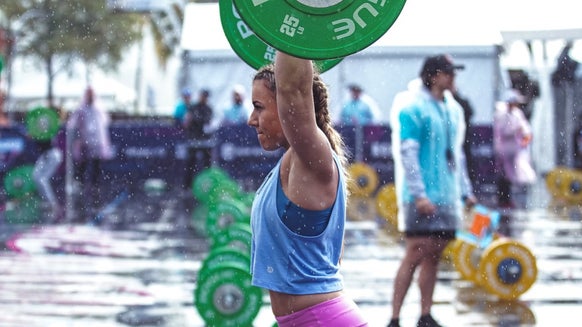How to train Like An MMA Fighter | Athlete Guides

With its impressive blend of fighting styles and unique personalities, it’s no wonder that MMA has built up a large following and continues to grow in popularity.
If you’re one of many who have been taken in by the physicality and skill of MMA fighters, read on to find out what it takes to train, eat and live like one of them.
What is MMA?
MMA, or mixed martial arts, is a combat sport that uses a combination of different fighting disciplines. It consists of three rounds of five minutes, and fighters are scored based on their performance in each round. The referee will call the fight if one fighter is knocked out, unable to continue, or submits.
Rules vary from federation to federation, but generally MMA incorporates a range of fighting techniques, including striking, grappling, and submissions. Certain moves, including groin strikes, headbutting, and biting, are illegal.
Benefits of MMA training
MMA training is incredibly demanding and intense. Whether your aim is to compete or to just try something new, there are plenty of benefits.
Enjoyment
MMA training is typically intense, so a tough workout is usually very good for improving your mood and reducing stress. It also usually involves working in a group, which is great for meeting people and forming new social connections.
Improves fitness and strength
MMA fighters are among some of the fittest athletes in the world. If you train like an MMA fighter, you’ll enjoy some of the same benefits, including strength, muscle endurance, and cardiovascular fitness.
Learning a new skill
MMA training equips you with a variety of combat skills and self-defence techniques, which may help you feel confident in certain situations.
The different styles of MMA fighting
MMA competitions generally fall into three main categories of combat styles, although there are still variations within these. While most people start by training in a particular style, they eventually diversify into other combat forms. The three categories are:
Stand-up: This category involves common combat sports styles like boxing, kickboxing, karate, muay Thai, krav maga, and taekwondo. Stand-up fighting involves face-to-face striking with hands, knees, elbows, and feet. Extensive training is needed to master the timing and power behind strikes for maximum impact. Stand-up fighting aims to dominate a round and achieve technical knockouts. Clinch: This style involves grabbing and holding in a standing position and draws from sports like judo and jiu-jitsu. Clinch fighting may suit people with a lower centre of gravity and shorter limbs. It emphasises close-quarter techniques, using momentum and gravity to throw opponents or win submissions. Ground: This category focuses on ground-based grappling, and makes use of wrestling and Brazilian jiu-jitsu techniques. The aim is to gain a position of submission or get into a striking position to achieve a knockout or technical knockout.
What are the three basics to training for MMA?
If you want to try your hand at MMA training, you should begin by focusing on these three areas.
Building endurance: A balanced combination of weight training, cardio, and circuit training is crucial. Set up intervals and circuits to last for five minutes or longer to give yourself the best chance of going the distance. Grappling: The best way to grips with this is to enlist a partner and get some mats. Focus on technical elements, like head or grip position, and learn how to use your weight to gain an advantage. Attending judo or jiu-jitsu classes is advised for some expert advice on technique and how to train safely. Basic striking: Fists, forearms, elbows, knees, shins, and feet can all be used. Focus on positional strikes like straight kicks or jabs to get your opponent into position to deliver a heavier strike, such as an uppercut, elbow strike, or roundhouse punch or kick. Kickboxing and taekwondo are two great disciplines for learning enhancing your striking.
Equipment for MMA fighting
Some federations may also require you to wear a helmet to protect your head from hard blows.
You may also want to invest in a few pieces of equipment to improve your training. Full boxing gloves can give additional protection to the hands, and foot and shin pads reduce pain to strikes to these areas. A punchbag may also be useful if you’re planning on training alone.
You can also wear a top, like a skin-tight performance tee, or a sports bra.
And for training, feel free to mix things up a bit. Bear in mind you’re likely to get hot, so something lightweight like a training T-shirt or a sweat-wicking base layer like the Engage Performance T-Shirt are ideal. On your bottom half, ventilated clothing like the Engage Shorts or Engage Baselayer Leggings help you to keep cool. And for women, the Engage Sports Bra provides great support.
Check out our combat clothing selection for more MMA training gear.
Train like an MMA fighter
Individual training schedules vary, but a weekly plan might look something like this:
Monday
Morning:
Interval training (Tabata) on the treadmill: 20 seconds on, 10 seconds off for 5 minutes, followed by 2 minutes of recovery. Repeat at least 3 times.
Afternoon:
Striking training for 1 hour, focusing on fist speed through partner pad work or solo bag work.
Tuesday
Morning:
Ground work for 1 hour, practising partner-supported drills to improve manoeuvring into a dominant position, followed by arm bars (rounds of 2 minutes with 2 minutes of recovery).
Wednesday
Rest and active recovery.
Thursday
Morning:
Power work for 45 minutes, incorporating weight training and plyometric exercises at 30-60% of 1RM. Perform 3 sets of 5 reps with 3 minutes of recovery.
Afternoon:
Grapple and throw exercises with a partner, focusing on sweeping and throwing to the floor. Perform rounds of 3 minutes with 1.5 minutes of recovery.
Friday
Circuit training including bodyweight ballistic movements, sprinting, and combat conditioning, such as heavy bag work and floor-to-standing movements.
Saturday
Rest and active recovery.
Sunday
Morning:
Strength work for 1 hour, focusing on compound lifts at 80% or more of 1RM. Perform 4 sets of 4 reps.
Afternoon:
Sparring sessions using a variety of techniques in 5-minute rounds, with a different focus on each round (eg standing, clinch, or ground techniques).1
The training plan you follow will be different depending on your personal goals and training phase. But you’ll need to take recovery seriously if you want to make sure you’re getting the most out of your training.
Best conditioning exercises for MMA
MMA is a full-body sport, so it's important to include exercises that improve full-body coordination. Here are some exercises to include in your training:
Offset overhead lunges (around 5% difference between sides) Battle ropes (various variations to enhance shoulder endurance) Kettlebell swings (excellent for hip function and power movements) Sled drags (attach a rope to a sled and pull it across the room) Torpedo buoy twist slams (hold the rope and perform Russian twists while slamming the ball)
For more ideas, check out the best strength and conditioning exercises for MMA.
MMA FAQs
What does an MMA fighter eat?
The diet of an MMA fighter will depend on their goals. If preparing for a fight or aiming to gain muscle mass, their diet will be focused on making weight.
Some weight-cutting practices are unhealthy and can leave you lacking energy and strength, though, so find out how to cut weight and the best weight-cutting foods.
Is MMA dangerous?
Like any contact sport, MMA comes with a risk of injuries. But with good quality training, injury prevention training, and technical training, the risk can be reduced.
Is MMA good for beginners?
MMA is a challenging and potentially complicated sport with many different styles and techniques. While having a martial arts background can help, you can still train and even compete against people of a similar level even if you’re a beginner. You can also complete the training without competing to develop your physicality.
Is MMA difficult to learn?
There are many components to MMA, which might make it challenging to pick up. But with discipline, good quality instruction, and support, you can learn to compete quickly.
How many hours a day do MMA fighters train?
The amount of training depends on the fighter's competitive level. Some UFC fighters may train for 2-4 hours per day in the lead-up to a fight, while off-season fighters may train 4-8 hours per week. Amateur fighters may need to fit training around their life commitments, so from 2-6 hours per week.
Can you train MMA by yourself?
While there are instructional videos available online, it can be dangerous to learn by yourself without proper guidance. It's recommended to go to group training sessions to start you off in the right direction.
Is MMA harder to learn than boxing?
MMA has more components to learn than boxing, which might make it harder to learn. That said, boxing has still has many different rules and elements, so it's by no means easy.
Take Home Message
While MMA continues to grow as a sport and many more people begin to take it up, it’s still a big commitment that requires serious training if you want compete seriously in it.
But if you’re just looking to get fit, pick up new skills, and meet some interesting people, you can still train like an MMA fighter to improve your strength and power.

How To Train Like A Bodybuilder | Athlete guides
We never said it was easy ...

How To Train Like A Strongman | Athlete Guides
Time to test your strength.

Simon started his fitness journey from a young age, and was playing sport as soon as he could roll a ball. This pushed him to compete in a variety of sports from rugby to squash.
After completing an MSc in Strength & Conditioning, alongside a PT qualification, he gained an academic role at the University of Chester. From lecturing to research-based studies, his applied role caters to both team and individual sports.







